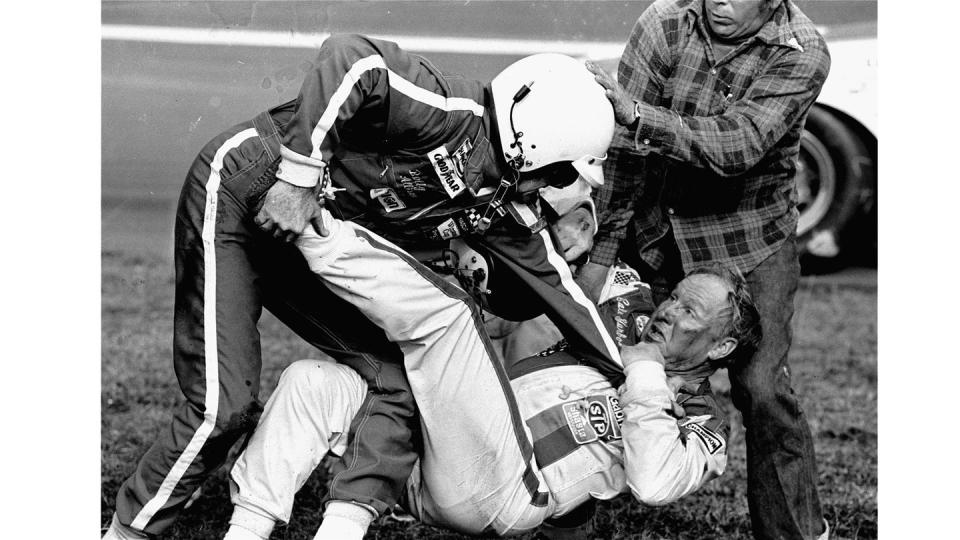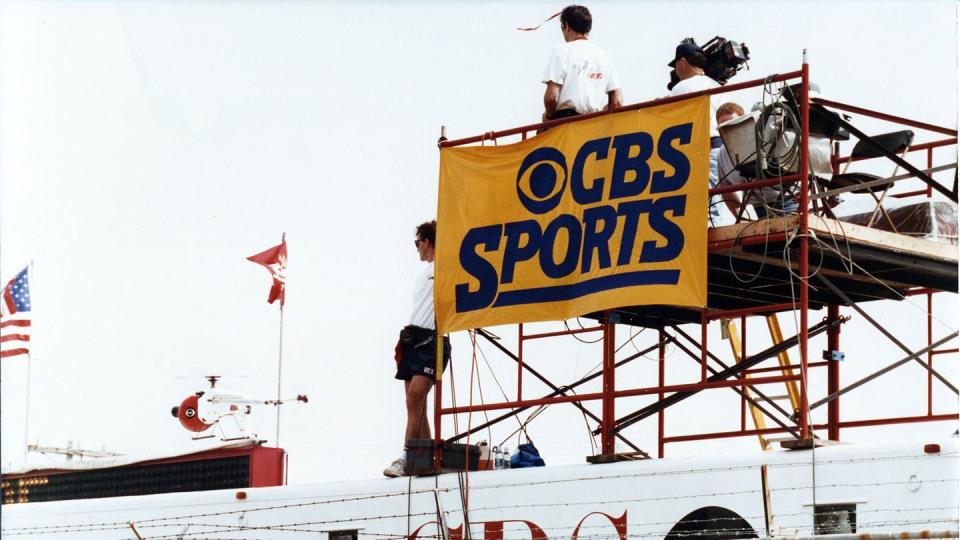How Cale Yarborough and CBS' Gamble on the 1979 Daytona 500 Put NASCAR on the Map

Editor's note: Today—December 31, 2023—we remember the great Cale Yarborough and his legacy that was cemented in NASCAR history at the 1979 Daytona 500 by re-posting this story originally published in 2019.
By a factor of two, it’s generally accepted that the 1979 Daytona 500 was the most significant race in NASCAR’s 71-year history.
To this day—more than 40 years and eight U.S. presidents later—it’s likely more Americans still remember the spectacular finish of that race than any other. Blizzard-like weather across much of the country contributed to an unprecedented TV audience for the first live, full-distance coverage of a major race.
Footage of the last-lap crash between Cale Yarborough and Donnie Allison—followed by their fight in turn 3 that included Bobby Allison—remains a staple of most Daytona 500 promotions.
This is how it went down.
CBS Sports president Neal Pilson snaked the Daytona 500 from ABC: “Ken Squier was our announcer when we did racing on delay, and he had a good relationship with the France family. In ’77 or ’78, he said we had a chance to get the property from ABC. I went down in ’78 and snuck around because I didn’t want ABC to know I was there. Ken and I eventually told (NASCAR president) Bill France that we’d do the 500 live if ABC didn’t get it live first. CBS management had challenged us to get as many of ABC’s top-quality events as we could, so we were on a mission. We paid a significant increase in rights fees to get the deal done.”
And was there ever a happier winner than Richard Petty, who raced that Sunday afternoon despite pleas from doctors to stay home and recover from his recent stomach surgery?

The weather’s role? A snowstorm paralyzed most of the eastern and northeastern United States. Millions of families were homebound because highways, airports and public transportation hubs were closed between Atlanta and Boston. The Saturday night storm was worse than expected and caught almost everybody unprepared. People had little choice but to stay inside and watch television.
From the 1979 National Weather Service archives: “It was one of the coldest Februarys on record from the eastern portions of the Great Plains through the Midwest to the North Coast states. The combination of cold and wet weather east of the Continental Divide yielded one of the snowiest Februarys on record in the Middle Atlantic states.”
In Delaware, Dover got 26 inches of snow that weekend. Baltimore and the Newark-New York area had 20. Washington, D.C., had 18. Atlantic City, Boston and Wilmington, Del., each had 17. Over in Pennsylvania, Harrisburg had 14 inches. Chicago got 12. It was minus-52 in Old Forge, New York, on race day, minus-15 in Caribou, Maine, and 10 degrees in Boston.
Autoweek spoke with most of the major players who had a role in making that race so memorable. We also have archived television commentary from the Cale Yarborough and the transcript of Motor Racing Network’s call of the famous last-lap wreck and the equally famous postrace fight.
The late Barney Hall began the call of the last lap from the Motor Racing Network booth.
“Here they come out of turn 4. The white flag is in Chip Warren’s hand as he gets ready to display it to Donnie Allison. Cale just tucked in there. When will Yarborough make his move? They flash across the stripe and white flag for Donnie Allison. They’re back in turn 1.”
Veteran radio and TV broadcaster Mike Joy was there: “Last lap. Donnie Allison is 20 car lengths back of brother Bobby. Donnie leads Cale Yarborough by two car lengths. They run up the racetrack. The Busch Oldsmobile stays aligned right on the back bumper of Donnie Allison. They’re out of turn 2. They’re down the backstretch. Here goes Cale on the inside!!!”
Announcer Gary Gerould was waiting: “Cale makes his move. He’s down very close to the grass. Donnie tries to cut him off. Cale’s in the grass! Cale loses it! He tries to pull it back. They’re side by side. They make contact. Both head for the wall. They hit the wall in turn No. 3. We’ll have a new leader. They’re diving down to the infield now as we look for the leaders coming up the back straightaway.”
Co-anchor Jack Arute from the booth: “They’re in turn 2 in front of Mike Joy.” Joy: “Here comes Richard Petty. He leads Darrell Waltrip by five car lengths. Five more lengths back to A.J. Foyt. Race traffic. Waltrip closes, but Petty is up there.” Arute: “Caution is on the racetrack, and it will be a battle back to the start-finish line.”
Gerould: “Heavy traffic in 3. Waltrip is running behind Petty. A.J. Foyt is right there. They move to the high side. They want to pass Tighe Scott. Richard brings them into 4.”
Eli Gold, the legendary voice of Alabama football, was there: “Richard Petty takes the outside. He’s got Darrell Waltrip close behind. Two car lengths back to A.J. Foyt. Richard Petty takes it to the trioval. He’s got the advantage right now.”
Hall: “Here they come to the stripe. Richard Petty’s STP Oldsmobile. Waltrip dives to the inside, and Petty almost put him off in the grass. And Richard Petty will win the Daytona 500.”Moments later, while Hall and Arute were recapping the race.
Gerould cut in: “Cale and Donnie... both out of their cars. Bobby Allison has brought his car down there. A furious discussion is taking place just down below the banks of turn No. 3. Now it appears we might have a fistfight. We see drivers and helmets. Safety officials are trying to jump in there and separate them. Tempers have really flared after this amazing incident on the last lap coming into turn No. 3. They battle on the ground at this time. We can’t see as others come running in to surround and separate these drivers.”
Arute quickly changed the subject: “In the meantime, it’s a very jubilant crew that’s heading to victory lane. We’ll be talking with them shortly, but first: From Daytona International Speedway, this is the MRN Broadcasting Co.”
Also on TV that day, Feb. 18: ABC aired its ‘Superstars’ show and later WBA junior lightweight boxing from San Juan between Sammy Serrano and Julio Valdez. NBC had college basketball with No. 5 Duke beating No. 9 Louisville by 16 in Charlotte, then Bruce Lietzke’s two-shot victory in the PGA’s Joe Garagiola Tucson Open.
Michael Hunt, a Florida attorney, has attended every Daytona 500: “I was 15 and excited to be there for the first live, start-to-finish televised race. They started on time and ran under green and caution for 15 laps because the track was wet (from morning rain). We had good seats (at $45), but they weren’t high enough to see past the infield scoreboard. I didn’t see clearly what happened in the crash, but I saw them go up into the wall at the end of the backstretch. I was listening to MRN and knew that Cale and Donnie had wrecked. It wasn’t until we got home and saw on the news what had happened in the wreck and the fight.”

 Yahoo Autos
Yahoo Autos 